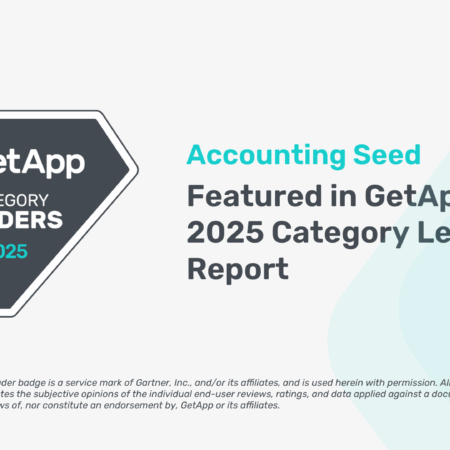
Small and midsize businesses (SMBs) face unique challenges when it comes to managing their finances, including limited staff, budget constraints, complex requirements, and growing data demands. Without the right software, maintaining your books can become a heavy burden and drain valuable time. In fact, one study found small business owners spend over 18 hours per week on accounting and payments tasks on average, eating away at precious hours that could be better allocated to strategic work. And that doesn’t even account for the insights lost when financial data is inaccurate or delayed, a major problem when 98% of C-Suite executives and financial and accounting professionals say they could be more confident in their current cash flow visibility.
The right accounting software can do a lot to take that burden off your shoulders, whether that’s through replacing manual work with automations, reducing errors, and overall giving you better visibility into the health of your organization. As an accounting software provider, we’ve helped hundreds of SMBs navigate the maze of tools to find solutions that work for them—and these are some of the most popular solutions we see businesses weighing in their search. Below, we walk through top accounting software options and what to consider when making your choice.
What to look for in accounting software:
When evaluating accounting software for your SMB, keep these key factors in mind:
Business needs & complexity: Start by identifying what’s broken in your current setup. Map your daily frustrations: time wasted on manual tasks, errors from duplicate data entry, missing financial insights, or delayed reporting. Then, weigh your needs against the offerings of the solutions in your search.
Scalability: Think about where your business is headed. Are you processing 50 invoices per month or 5000? Will that number double next year? Choose software that can handle your growth trajectory without breaking down or forcing expensive upgrades. Look at user limits, transaction capacity, and how the pricing scales as you add volume.
Must-have features: Look for core functionality like automated accounts receivable (invoicing, payment reminders) and accounts payable (bill tracking, approvals) to save time. Modern solutions often include AI capabilities, such as smart transaction categorization or predictive insights, which become more valuable as transaction volume increases.
Integrations (or built-in connectivity): How well does the accounting software connect with your other sources of data? It’s important that it integrates easily with your CRM, payment processors, e-commerce platform, and other business tools so you don’t end up with data silos. If you’re using a platform like Salesforce, you can avoid traditional integrations altogether—tools like Accounting Seed are built directly on the Salesforce Platform, meaning your sales, financials, and operational data live in one unified environment with no syncing required.
Support & resources: Consider the quality of customer service and the availability of help resources or user communities. Especially for SMBs without in-house IT, responsive support and ample documentation can be a lifesaver.
Security & compliance: Financial data is sensitive, so robust security is non-negotiable. Look for features like data encryption, role-based user permissions, regular backups, and two-factor authentication.
Data readiness & AI preparation: For AI and automation to work most effectively, your financial data needs to live in the same environment as your customer and operational data. When accounting runs on a separate platform from your CRM (such as with Salesforce and Quickbooks, or Salesforce and NetSuite), you end up with conflicting customer records and constant data syncing issues. Look for solutions that unify your data in one place—like accounting built directly on your CRM platform—so AI tools can access clean, consistent information without the errors that can come from transferring data between systems.
Best accounting software for small businesses
For small businesses (from solo entrepreneurs up to companies with 20-50 employees), user-friendliness and cost-effectiveness are often top priorities. Here are some of the top solutions to consider, organized from those best suited for the smallest operations to those designed for growing small businesses.
Wave
Wave is an accounting tool ideal for freelancers, consultants, and very small businesses. It covers basic needs like invoicing, expense tracking, and receipt scanning without any subscription fee for its starter plan. Wave’s appeal has traditionally been its $0 price for core features, including a mobile app for creating invoices on the go.
Wave also offers paid add-ons like credit card processing and payroll that integrate with the accounting side. The solution is generally accessible to non-accountants and provides useful financial reports for a free product. However, Wave is not ideal for scaling up; it lacks advanced features like project tracking or detailed customization options, and its customer support is limited (for example, no phone support for free users). Wave delivers on the basics for micro-businesses and self-employed folks on a tight budget, but larger or growing businesses will eventually need more power.
FreshBooks
FreshBooks is designed with service-based businesses and freelancers in mind, offering an invoice-centric accounting experience. It combines invoicing, time tracking, and basic project accounting, and makes it simple to log billable hours, track expenses (including snapping photos of receipts via its mobile app), and send polished invoices to clients. It can also automate tasks like recurring invoices and payment reminders.
FreshBooks offers a helpful mobile app and user experience; many users find it more intuitive than larger competitors. The trade-off is that FreshBooks is less comprehensive on pure accounting features—it handles basic double-entry bookkeeping and reports, but is not as deep as products like QuickBooks or Xero. Also, FreshBooks’ plans come with strict user limits, with an added fee for each extra user. FreshBooks may work for solo professionals and small teams that prioritize invoicing and time tracking, though it may be less suitable for growing accounting departments.
Zoho Books
Zoho Books offers an affordable and automation-friendly accounting solution, particularly attractive if your business already uses other Zoho applications (like Zoho CRM). Out of the box, Zoho Books includes invoicing, expense tracking, project time tracking, inventory management, and project management tools. Zoho’s dashboard highlights key financial metrics like income, expenses, and cash flow at a glance.
The system allows a high degree of automation through features like bank rules for auto-categorizing transactions and recurring workflows, helping reduce manual data entry. One notable benefit is Zoho Books’ free plan for very small businesses: if your annual revenue is under $50,000, Zoho offers a free tier with basic functionality. The trade-off with Zoho Books is that while it covers most features a small business would need, it lacks some of the advanced features of competitor solutions.
Xero
Xero is a popular cloud-based accounting software known for its user-friendly design and well-rounded feature set, making it a top alternative to QuickBooks for small businesses. One of Xero’s distinguishing features is that it allows unlimited users on all its plans (no per-seat pricing). Xero’s dashboard provides a clear snapshot of your finances—including cash flow, bank balances, invoices owed, and bills to pay—in real time.
It also automates bank feeds and transaction reconciliations: Xero will import your bank transactions and suggest matches to your invoices or expense entries, reducing manual bookkeeping work. Small businesses that need inventory tracking may be able to get by with Xero’s limited inventory management features. Additionally, Xero offers an ecosystem of over 800 third-party integrations, giving it flexibility to slot into your toolkit.
Users often comment on Xero’s minimalist design and clear language, which make it approachable if you don’t have an accounting background. Compared to QuickBooks Online, Xero tends to be more affordable and includes things like multi-currency and project tracking in mid-tier plans. On the downside, Xero’s customer support is primarily online, and they do not offer phone support.
QuickBooks Online (Simple Start / Essentials / Plus)
QuickBooks Online (QBO) remains one of the most popular choices for small businesses, due to its extensive features, familiarity, and the vast ecosystem of integrations and advisor support around it. Intuit offers QBO in multiple plans (Simple Start, Essentials, and Plus) allowing businesses to start with basic functionality and scale up as needed. QuickBooks Online covers invoicing, expense and bank transaction tracking (with bank feeds), bill payment management, financial reporting, and inventory and project tracking (in the Plus plan).
The interface is modern and fairly intuitive, with a customizable dashboard and plenty of pre-built reports. QBO connects with over 750 other business apps out of the box, meaning you can hook it up to your CRM, e-commerce site, payment processors, and more—however, these integrations can break and often cause frequent data syncing delays.
There’s also a large community of accountants and Certified ProAdvisors familiar with QuickBooks, so finding external help or resources is usually easy. Keep in mind some limitations: each plan supports only a limited number of billable users, so as your team grows you may need to upgrade plans. Additionally, certain advanced features like enhanced analytics dashboards come only in higher tiers or via add-ons.
Sage 50
Sage 50 (formerly Peachtree) is a long-standing small business accounting software that offers a desktop-based solution with accounting functionality. It’s best for small businesses that don’t necessarily need a purely cloud system and prefer the reliability of a desktop application. Sage 50 includes features such as inventory management, job costing, and detailed reporting. Its higher editions support advanced inventory tracking (with multiple pricing levels, backorder tracking, etc.), industry-specific reports, and integrated payroll (payroll is an add-on service).
Many long-time users find Sage 50 straightforward to use and appreciate its reliable performance and customer support. It also allows audit trails and uses true double-entry accounting, which more traditional bookkeepers value.
However, being a desktop software, Sage 50 lacks the mobility of cloud solutions; there is no full-featured mobile app or web interface. In addition, its inventory capabilities are limited to single-location tracking—businesses managing stock across multiple warehouses will need to look elsewhere. Some users have expressed frustration with periodic software updates causing issues and feel that Sage 50’s technology is aging in an era when most competitors are fully cloud-based. Sage 50 can work if your business prefers a traditional accounting program installed on your computer or server, but you should consider whether a cloud solution might offer more flexibility. All in all, compared to other ERPs on the market, users find Sage 50 to be significantly more limited.
Best Accounting Software for Midsize Businesses
As businesses grow in headcount and complexity, their accounting needs often become more demanding. Midsize businesses may require multi-user collaboration, more advanced reporting, and features like multi-entity consolidation, and workflow automations.
QuickBooks Online Advanced
QuickBooks Online Advanced is Intuit’s offering for businesses that have outgrown the standard QuickBooks Online tiers. QBO Advanced increases the user limit to 25 full-access users (versus 5 in QBO Plus) and provides more granular permissions. It also comes with advanced reporting, including custom dashboards and the integration of Fathom (a financial analysis tool) for deeper insights.
In QBO Advanced, you can create rule-based triggers, batch-process transactions, and set up approval workflows for expenses or bills. These automations can reduce manual work for high-volume transactions or multi-step processes. However, companies should be mindful that it still has some inherent limitations of QuickBooks Online. Very large transaction volumes or multi-entity accounting may strain its capabilities, and certain advanced functions might require third-party add-ons.
Sage Intacct
Sage Intacct is a cloud-based financial management and ERP solution tailored toward finance teams needing deeper accounting functionality and compliance. Intacct supports GAAP-compliant accounting including revenue recognition, deferred revenue management, and project accounting. With Intacct, you can tag transactions with dimensions (like department, location, project, customer, etc.) and then filter or aggregate reports.
However, the Intacct platform can feel rigid, and what seems affordable initially often grows quickly when factoring in implementation, training, and the ongoing maintenance of integrations. Despite its audit-ready capabilities, many growing businesses find themselves constrained by disconnected data and surprise costs over time.
NetSuite ERP
Oracle NetSuite is a cloud ERP that combines accounting, CRM, inventory management, and e-commerce modules in a single platform. Designed for upper-midsize businesses, it handles advanced revenue recognition, multi-currency consolidation, and GAAP-compliant accounting. The platform aims to serve as a unified system for company operations, allowing businesses to manage accounting, orders, inventory, and fulfillment with shared real-time data.
However, NetSuite users often report implementation challenges. Simple changes like modifying workflows or adding custom fields typically require engineering resources and custom code. Some businesses find themselves creating workarounds outside the system—marketing agency KPS3, for instance, had to maintain a 400-row spreadsheet outside of NetSuite just to manage billing, with teams manually creating 350-400 invoices each month and working overtime to close their books. Companies using a CRM outside of NetSuite’s ecosystem (like Salesforce) face particular challenges, paying for complexity they don’t need while still dealing with disconnected data between their sales and accounting systems.
Acumatica
Acumatica is a cloud ERP for small and mid-sized businesses with unlimited user licensing—you pay based on resources rather than per-seat, enabling broad team access without escalating costs. The platform covers financial management, distribution, manufacturing, project accounting, and CRM, with AI-driven features like automated document recognition. Industry-specific editions provide tailored functionality for manufacturing, construction, and retail. Built cloud-first, it offers flexible deployment options (public cloud, private cloud, or on-premises) and mobile access. However, implementation quality varies since Acumatica sells through VARs (Value Added Resellers).
Microsoft Dynamics 365 Finance
Microsoft Dynamics 365 Finance delivers enterprise-grade accounting for midsize and larger organizations, particularly those using Microsoft tools beyond the standard Office Suite. The cloud solution integrates with Office 365, Power BI, and Dynamics CRM modules, enabling Excel data exports and Power BI dashboards directly from financial data. AI features assist with budget proposals, cash flow forecasting, and automated workflows. The platform handles complex operations including multi-company consolidation, global reporting, and project accounting across various industries.
However, customizing business processes requires significant technical resources or partner support, and the interface can feel outdated compared to modern cloud solutions. Companies using Salesforce as their CRM face ongoing integration challenges—third-party connectors require constant maintenance and can create data synchronization issues similar to those experienced with NetSuite and Sage Intacct. While scalable, Dynamics 365 Finance suits upper-midsize companies already invested in Microsoft tools rather than those committed to other platforms like Salesforce.
Best Solution for SMBs on Salesforce
If your business already uses Salesforce as a CRM (or plans to), using a Salesforce-native accounting solution can eliminate many integration headaches. Traditional accounting software requires connectors or data sync between your CRM and your finance system, which can lead to delays or discrepancies in data. In contrast, a native solution means your accounting lives inside Salesforce—your customer data, sales data, and financial data all share the same database. This creates a single source of truth and a unified view of your business without needing complex integrations. It also improves reliability (no worries about APIs failing or data mapping issues) and real-time reporting (since every invoice or payment record is immediately available for dashboards and analytics within Salesforce).
Accounting Seed
Accounting Seed is built entirely on Salesforce’s core platform, meaning your CRM and accounting share the same data environment. Sales opportunities can be converted to invoices, customer records tie directly to transactions, and you can achieve a 360° view of your customers (sales history and payment status) in one place. This native architecture eliminates the sync delays and data discrepancies that often plague integrated CRM-accounting setups. All your financial data lives in Salesforce, giving you real-time, holistic insight into cash flow and profitability alongside your customer and sales pipeline data.
No-code customization
Because it resides in Salesforce, Accounting Seed inherits the platform’s powerful no-code customization capabilities. Finance teams (or your Salesforce admin) can modify workflows, create custom fields/objects, and build tailor-made reports or automations using clicks instead of code. For instance, you could create a custom object to track industry-specific financial metrics, or use Salesforce Flow to automate an approval process for large expenditures—all within Accounting Seed. This flexibility means the software can adapt to your business processes without costly development work.
Built-in automations
Accounting Seed places a strong emphasis on automation of accounting processes. It offers pre-built, configurable automation for accounts receivable (automatically sending invoices and payment reminders, recording payments against invoices), accounts payable (automating bill entry, approvals, and check or electronic payments), bank reconciliation (auto-matching bank transactions), and revenue recognition schedules for deferred revenue. These features can dramatically reduce manual bookkeeping work and lower time spent on activities like cash collection by up to 80%. The result is fewer errors and a finance team that can focus on analysis rather than data entry.
Real-time financial visibility
Since your financial transactions are recorded in the same system as your operational data, you get instant, real-time visibility into your financial performance. Accounting Seed leverages Salesforce’s reporting and dashboard tools to provide up-to-the-minute views of key metrics like cash balance, receivables aging, revenue vs. budget, and more. You no longer have to wait for data syncs or manually compiled reports; a sales order turned into an invoice is immediately reflected in revenue reports and on your Salesforce dashboards. This real-time insight, coupled with multi-dimensional reporting (you can analyze financial data by any attribute, be it by product, region, project, etc.), means better decision-making and the agility to spot issues or trends as they happen.
Complete accounting suite
Accounting Seed covers standard accounting functions—general ledger, revenue management, billing, payables, project accounting, and more—all within Salesforce. For SMBs on Salesforce (or who plan to use it), this can be the best of all worlds: you maintain one system for your core business data.
Recommendations and next steps
Choosing the right accounting software is one of the smartest financial decisions you can make for your business. The proper solution will save time, improve accuracy, and support long-term growth by giving you better financial clarity and control. There’s no one-size-fits-all answer, as the ideal choice depends on your company’s size, complexity, growth plans, and the systems you already use. Here are some next steps to help you move forward:
- Assess your needs: Start with a thorough assessment of your business requirements. Identify the must-have features (AR automation/AP automation, multi-currency support, AI capabilities, etc.), and also consider future needs based on your growth plans.
- Take advantage of trials/demos: Once you have a shortlist, use free trials and product demos to evaluate each option. Pay attention to the user interface and navigation—can you see yourself and your team comfortably using this software daily? Test some typical workflows (create an invoice, run a report, connect a bank feed) to see how intuitive it is. Keep in mind that just because new software looks different from what you’re using now doesn’t mean you should dismiss it. Change can bring efficiency gains and better ways of working—sometimes the unfamiliar interface that seems daunting at first actually represents a smarter approach to getting things done.
- Consider support and community: Research the level of support and resources available for each solution. Is there live support when you encounter an issue? Do they have an extensive knowledge base or user community forums? For small businesses without an IT department, knowing you can get help quickly is important.
- Plan the implementation: Think about the process of moving to the new software. How easy is it to migrate your existing financial data over? Some tools offer migration wizards or have partners that can assist with data import. Be realistic about the time and resources needed to get set up. The right software provider will help match you with the best implementation partner for your specific needs.
- Connect with Accounting Seed for guidance: If you’re evaluating alternatives and want to understand how a Salesforce-native solution could transform your financial operations, reach out to our team at Accounting Seed. We can help you assess your current challenge and determine if our unified platform approach is the right fit for your business. Our experts understand the specific pain points of managing disconnected systems and can show you how operating within a single platform eliminates integration headaches while preparing you for future growth.
By following these steps, you’ll be well on your way to finding an accounting software solution that fits your needs and sets you up for success. The goal is to have a tool that truly improves your financial management efficiency and insight. Take your time, do the homework, and soon you’ll reap the benefits of a system that lets you focus more on growing your business and less on wrestling with numbers.
See Accounting Seed in action
See how accounting on Salesforce can eliminate the need for costly integrations—and silos of mismatched information—by sharing the same database as your CRM.



